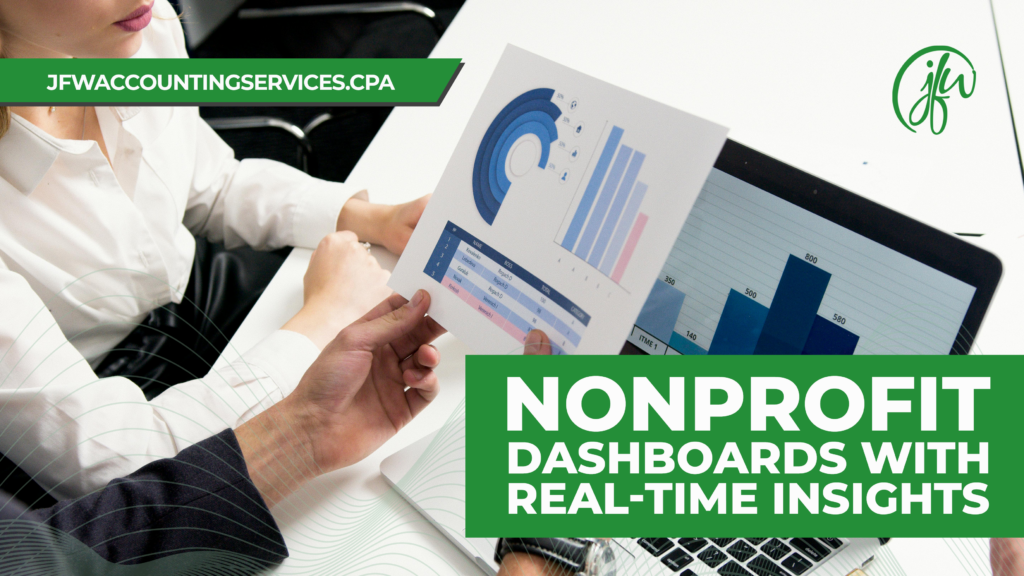Nonprofit dashboards, as essential tools, consolidate key metrics and insights into a single, visually accessible interface. They act as a ‘control center’ for nonprofit organizations, providing at-a-glance overviews of crucial data such as finances, fundraising progress, program outcomes, and operational efficiency. By transforming raw data into actionable insights, nonprofit dashboards empower leadership teams to make informed, timely decisions that align with their mission, thereby enhancing organizational performance and transparency.
Now more than ever, transparency and impact are key drivers of donor trust and engagement, dashboards play a crucial role. They streamline communication by presenting complex data clearly and compellingly, thereby enhancing the organization’s credibility. This article explores nonprofit dashboards, their significance, and practical answers to key questions about their implementation and value.
Understanding Nonprofit Dashboards
Nonprofit dashboards are visual tools that transform complex data into clear, actionable insights. They enable organizations to track performance, monitor trends, and make informed decisions. By presenting key metrics in a user-friendly format, dashboards help nonprofit leaders quickly assess fundraising progress, evaluate program effectiveness, and identify opportunities for improvement.
Key elements of nonprofit dashboards often include financial KPIs, such as cash flow and donor retention rates, and metrics related to program outcomes and operational efficiency. These dashboards provide real-time data tailored to specific roles or organizational needs, ensuring that every decision relies on accurate and relevant information.
But does a nonprofit need a dashboard? The answer is a resounding yes. In an environment where transparency and accountability are paramount, dashboards are not just tools, they are beacons of trust. They empower nonprofits to showcase their impact effectively, optimize resources, and align actions with their mission—making them indispensable tools for modern nonprofit management. They reassure stakeholders and build confidence in the organization’s operations.
Key Performance Indicators (KPIs) for Nonprofits
Key Performance Indicators (KPIs) are the backbone of nonprofit organizations, providing measurable metrics to evaluate progress toward goals, monitor performance, and make data-driven decisions. These metrics are essential for understanding the organization’s overall impact and ensuring that resources are allocated effectively to maximize results.
What is a KPI in a non-profit organization? A KPI is a specific measurement that reflects the success of a particular activity or goal. For nonprofits, this might include metrics like donor retention rates, program reach, and operational efficiency. For instance, the donor retention rate tracks the percentage of repeat donors, offering insight into the effectiveness of donor engagement strategies. Similarly, a program expense ratio evaluates how effectively the organization allocates resources to support its mission directly, fostering transparency and trust among stakeholders.
To identify and prioritize relevant KPIs, nonprofits should align their metrics with their mission and strategic objectives. Start by defining what success looks like for your organization and choose indicators that provide actionable insights. By focusing on KPIs that matter most, nonprofits can create impactful dashboards that guide decision-making, improve transparency, and provide a secure and guided path to demonstrate progress to donors, board members, and staff.
Types of Nonprofit Dashboards
Nonprofit dashboards come in various forms, each tailored to meet organizational needs and priorities. These dashboards provide critical insights that help nonprofits achieve their goals, monitor operations, and evaluate impact.
Strategic Dashboards
Strategic dashboards, or KPI dashboards, focus on long-term goals and high-level outcomes. They highlight metrics like donor retention, program reach, and fundraising progress. For example, a nonprofit might use a strategic dashboard to monitor how effectively its programs align with its mission over time.
Operational Dashboards
Operational dashboards track the organization’s day-to-day activities and ensure smooth program execution. These dashboards might display volunteer engagement metrics, cash flow, or event logistics. For instance, an operational dashboard can help a team manage volunteer scheduling and retention, ensuring the organization meets its immediate objectives.
Analytical Dashboards
Analytical dashboards focus on data trends and predictive insights, enabling nonprofits to identify patterns and make forward-looking decisions. These dashboards often include metrics like social media engagement or grant acquisition rates, providing a foundation for crafting strategies that amplify impact.
What are the different types of nonprofit dashboards? Nonprofit dashboards range from financial dashboards that track revenue and expenses to project-specific dashboards that monitor timelines and deliverables. Organizations can better align resources, improve transparency, and drive meaningful change by selecting the right dashboard type.
Sage Intacct Dashboards for Nonprofits
Sage Intacct is a leading provider of cloud-based nonprofit dashboard solutions. It empowers organizations with the tools to drive mission success. Its dashboards deliver real-time visibility into financial health, program outcomes, and organizational performance, providing nonprofits with actionable insights at every level.
Key Features of Sage Intacct Dashboards
- Real-time insights – Nonprofits can track financial metrics, fundraising progress, and program effectiveness.
- Integration capabilities – Seamlessly connect with donor management tools, CRM systems, and budgeting software for a unified data view.
- Automated reporting and consolidation – Multi-entity organizations benefit from streamlined reporting, eliminating the need for manual consolidations.
Supporting Nonprofits with Tailored Solutions
Sage Intacct dashboards adapt to each nonprofit’s unique needs. They provide advanced customization options, allowing organizations to create role-based dashboards for team members such as Executive Directors or CFOs. Additionally, compliance dashboards ensure financial transparency and simplify audit preparation by displaying real-time data aligned with nonprofit accounting standards.
Practical Examples of Success
Organizations like the International Living Future Institute leverage Sage Intacct nonprofit dashboards for personalized insights that improve decision-making and accountability across teams. Similarly, the Marguerite Casey Foundation uses compliance dashboards to maintain audit readiness and enhance financial transparency.
By choosing tools like Sage Intacct, nonprofits can ensure their dashboards are functional and scalable, providing the foundation for future growth and mission success.
Building a Nonprofit Dashboard
Creating an effective nonprofit dashboard requires careful planning to ensure it is a meaningful tool for decision-making and progress tracking. Follow these steps to design a dashboard tailored to your organization’s unique needs:
- Identify Objectives and Key Metrics
Begin by defining your organization’s most critical goals. Then, select metrics that align with these objectives. Focus on key indicators that track progress toward mission success, such as donor retention, program outcomes, or financial health. - Choose the Right Tools and Software
Select software that fits your organization’s needs and budget. Tools like Sage Intacct or Tableau offer advanced features, including real-time data visualization and integration with donor management systems. - Integrate Data Sources
To create a comprehensive view, combine data from various systems, such as accounting software, CRM tools, and program databases. This ensures that leadership teams have access to all relevant information in one place. - Ensure the Dashboard is User-Friendly
Design the dashboard with simplicity and accessibility in mind. A clear layout, visual cues like color-coded indicators, and role-specific customization can make the dashboard easier for all stakeholders.
How do I create a nonprofit advisory board?
While building your dashboard, involve your advisory board in reviewing and refining the metrics. Advisory boards provide valuable feedback on whether selected indicators resonate with the organization’s mission and offer insights into improvement opportunities.
By following these steps, nonprofit dashboards become a tool for measurement and a driver of organizational learning and impact.
Benefits and Best Practices
Nonprofit dashboards offer transformative benefits for organizations seeking to maximize their impact. By consolidating key metrics into a single interface, dashboards enhance transparency and accountability, enabling stakeholders to understand progress and results clearly. Real-time insights improve decision-making, allowing leadership to allocate resources effectively and optimize fundraising efforts.
To fully leverage nonprofit dashboards, adhere to these best practices:
- Regular Updates and Reviews – Ensure data is updated frequently to maintain relevance and accuracy. Schedule periodic reviews to align metrics with evolving organizational goals.
- Customization – Tailor dashboards to fit your nonprofit’s unique needs, focusing on mission-critical metrics that matter most to your audience.
- Staff Training – Equip team members with the skills to navigate and interpret dashboard data effectively, fostering a culture of informed decision-making.
Implementing these practices can help nonprofits unlock the full potential of dashboards to drive strategic growth and mission success.
Final Thoughts
Nonprofit dashboards are invaluable tools for optimizing organizational performance, enabling data-driven decisions, and effectively showcasing impact. Investing in solutions like Sage Intacct ensures your nonprofit stays transparent, accountable, and mission-focused. Take the next step toward strategic growth—schedule an assessment with JFW Accounting Services to build a dashboard tailored to your goals.

Jo-Anne Williams Barnes, is a Certified Public Accountant (CPA) and Chartered Global Management Accountant (CGMA) holding a Master’s of Science in Accounting (MSA) and a Master’s in Business Administration (MBA). Additionally, she holds a Bachelor of Science (BS) in Accounting from the University of Baltimore and is a seasoned accounting professional with several years of experience in the field of managing financial records for non-profits, small, medium, and large businesses. Jo-Anne is a certified Sage Intacct Accounting and Implementation Specialist, a certified QuickBooks ProAdvisor, an AICPA Not-for-Profit Certificate II holder, and Standard for Excellence Licensed Consultant. Additionally, Jo-Anne is a member of American Institute of Certified Public Accountant (AICPA), Maryland Association of Certified Public Accountants (MACPA), and Greater Washington Society of Certified Public Accountants (GWSCPA) where she continues to keep abreast on the latest industry trends and changes.

